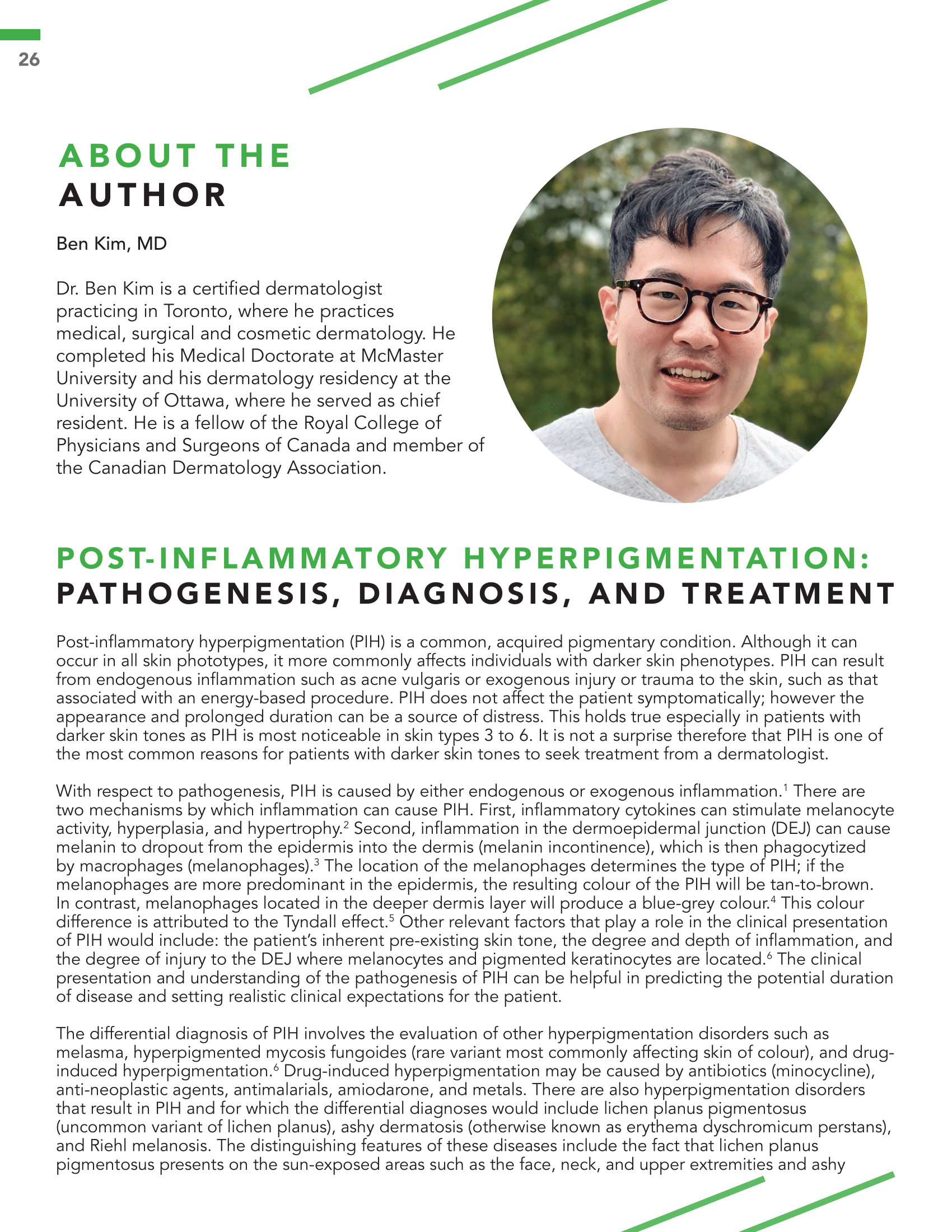Post-Inflammatory Hyperpigmentation: Pathogenesis, Diagnosis, and Treatment
Abstract
Post-inflammatory hyperpigmentation (PIH) is a common, acquired pigmentary condition. Although it can occur in all skin phototypes, it more commonly affects individuals with darker skin phenotypes. PIH can result from endogenous inflammation such as acne vulgaris or exogenous injury or trauma to the skin, such as that associated with an energy-based procedure. PIH does not affect the patient symptomatically; however the appearance and prolonged duration can be a source of distress. This holds true especially in patients with darker skin tones as PIH is most noticeable in skin types 3 to 6. It is not a surprise therefore that PIH is one of the most common reasons for patients with darker skin tones to seek treatment from a dermatologist.
References
Callender, Valerie D., et al. ”Postinflammatory hyperpigmentation.” American journal of clinical dermatology 12.2 (2011): 87-99.
Papa CM, Kligman AM. The behavior of melanocytes in inflammation. J Invest Dermatol. 1965;45:465-473.
Nordlund, James J. ”Postinflammatory hyperpigmentation.” Dermatologic clinics 6.2 (1988): 185-192.
Lamel SA, Rahvar M, Maibach HI. Postinflammatory hyperpigmentation secondary to external insult: an overview of the quantitative analysis of pigmentation. Cutan Ocul Toxicol. 2013;32(1):67-71. doi:10.3109/15569527.2012.6 84419
King M. Management of Tyndall Effect. J Clin Aesthet Dermatol. 2016;9(11):E6-E8.
Postinflammatory hyperpigmentation: A comprehensive overview Silpa-archa, Narumol et al. Journal of the American Academy of Dermatology, Volume 77, Issue 4, 591 – 605
BOLOGNIA, J., JORIZZO, J. L., & SCHAFFER, J. V. (2012). Dermatology. [Philadelphia], Elsevier Saunders.
Ruiz-Maldonado R, Orozco-Covarrubias ML. Postinflammatory hypopigmentation and hyperpigmentation. Semin Cutan Med Surg. 1997;16:36-43.
Pavlovsky L, Mimouni D, Amitay-Laish I, et al. Hyperpigmented mycosis fungoides: an unusual variant of cutaneous T-cell lymphoma with a frequent CD81 phenotype. J Am Acad Dermatol. 2012;67:69-75.
Palumbo A, d’Ischia M, Misuraca G, et al. Mechanism of inhibition of melanogenesis by hydroquinone. Biochim Biophys Acta. 1991;1073:85-90.
Kligman AM, Willis I. A new formula for depigmenting human skin. Arch Dermatol. 1975;111:40-48.
Kang HY, Valerio L, Bahadoran P, Ortonne J-P. The role of topical retinoids in the treatment of pigmentary disorders: an evidence-based review. Am J Clin Dermatol. 2009;10(4):251-260. doi:10.2165/00128071-200910040-00005
Bulengo-Ransby SM, Griffiths CE, Kimbrough-Green CK, et al. Topical tretinoin (retinoic acid) therapy for hyperpigmented lesions caused by inflammation of the skin in black patients. N Engl J Med. 1993;328(20):1438- 1443. doi:10.1056/NEJM199305203282002
Grimes P, Callender V. Tazarotene cream for postinflammatory hyperpigmentation and acne vulgaris in darker skin: a double-blind, randomized, vehicle-controlled study. Cutis. 2006;77(1):45-50.
Tanghetti E, Dhawan S, Green L, et al. Randomized comparison of the safety and efficacy of tazarotene 0.1% cream and adapalene 0.3% gel in the treatment of patients with at least moderate facial acne vulgaris. J Drugs Dermatol JDD. 2010;9(5):549-558.
Joshi SS, Boone SL, Alam M, et al. Effectiveness, safety, and effect on quality of life of topical salicylic acid peels for treatment of postinflammatory hyperpigmentation in dark skin. Dermatol Surg Off Publ Am Soc Dermatol Surg Al. 2009;35(4):638-644; discussion 644. doi:10.1111/j.1524-4725.2009.01103.x
Refaei AE, Salam HA, Sorour N. Salicylic– mandelic acid versus glycolic acid peels in Egyptian patients with acne vulgaris. J Egypt Womens Dermatol Soc. 2015;12(3):196-202. doi:10.1097/01.EWX.0000464740.18592.42
Sarkar R, Ghunawat S, Garg VK. Comparative Study of 35% Glycolic Acid, 20% Salicylic-10% Mandelic Acid, and Phytic Acid Combination Peels in the Treatment of Active Acne and Postacne Pigmentation. J Cutan Aesthetic Surg. 2019;12(3):158-163. doi:10.4103/JCAS. JCAS_135_18
How KN, Lim PY, Kammal WSLWA, Shamsudin N. Efficacy and safety of Jessner’s solution peel in comparison with salicylic acid 30% peel in the management of patients with acne vulgaris and postacne hyperpigmentation with skin of color: a randomized, double-blinded, split-face, controlled trial. Int J Dermatol. 2020;59(7):804-812. doi:https://doi. org/10.1111/ijd.14948
Castanedo-Cazares JP, Lárraga-Piñones G, Ehnis-Pérez A, et al. Topical niacinamide 4% and desonide 0.05% for treatment of axillary hyperpigmentation: a randomized, double-blind, placebo-controlled study. Clin Cosmet Investig Dermatol. 2013;6:29-36. doi:10.2147/ CCID.S39246
Weiss SC, Nguyen JC, Chon SY, Kimball AB. A randomized controlled clinical trial assessing the effect of betamethasone valerate 0.12% foam on the short-term treatment of stasis dermatitis. J Drugs Dermatol JDD. Published online 2005.
Kim D, Kang WH. Role of dermal melanocytes in cutaneous pigmentation of stasis dermatitis: a histopathological study of 20 cases. J Korean Med Sci. 2002;17(5):648-654. doi:10.3346/jkms.2002.17.5.648
Hakozaki T, Minwalla L, Zhuang J, et al. The effect of niacinamide on reducing cutaneous pigmentation and suppression of melanosome transfer. Br J Dermatol. 2002;147(1):20-31. doi:10.1046/j.1365-2133.2002.04834.x
Philipp-Dormston WG, Vila Echagüe A, Pérez Damonte SH, et al. Thiamidol containing treatment regimens in facial hyperpigmentation: An international multi-centre approach consisting of a double-blind, controlled, split-face study and of an open-label, real-world study. Int J Cosmet Sci. 2020;42(4):377-387. doi:10.1111/ics.12626
Mann T, Gerwat W, Batzer J, et al. Inhibition of Human Tyrosinase Requires Molecular Motifs Distinctively Different from Mushroom Tyrosinase. J Invest Dermatol. 2018;138(7):1601- 1608. doi:10.1016/j.jid.2018.01.019
Kim S, Lee J, Jung E, et al. Mechanisms of depigmentation by alpha-bisabolol. J Dermatol Sci. 2008;52(3):219-222. doi:10.1016/j. jdermsci.2008.06.005
Lee J, Jun H, Jung E, Ha J, Park D. Whitening effect of α-bisabolol in Asian women subjects. Int J Cosmet Sci. 2010;32(4):299-303. doi:10.1111/j.1468-2494.2010.00560.x
Ha JH, Kang WH, Lee JO, et al. Clinical evaluation of the depigmenting effect of Glechoma Hederacea extract by topical treatment for 8 weeks on UV-induced pigmentation in Asian skin. Eur J Dermatol EJD. 2011;21(2):218-222. doi:10.1684/ejd.2010.1232


